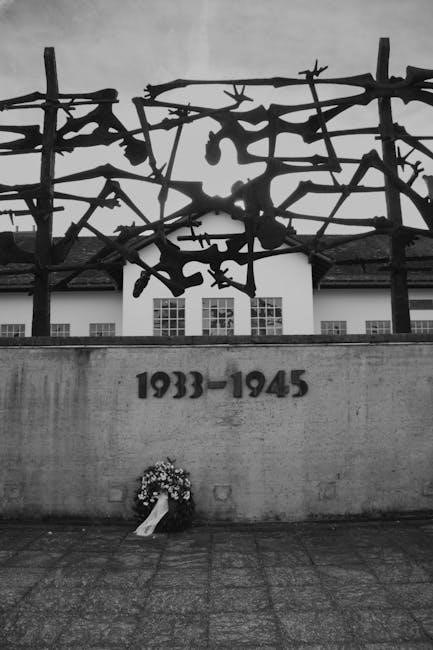William Worden’s Tasks of Mourning provide a structured framework for understanding and navigating grief, offering practical steps to integrate loss into life while fostering emotional healing․
Overview of the Four Tasks of Mourning
William Worden’s Four Tasks of Mourning offer a clear, actionable framework for navigating grief․ The tasks include: Accepting the reality of the loss, which involves acknowledging the permanence of the death; Processing the pain of grief, where individuals confront and express their emotions; Adjusting to a world without the deceased, requiring practical and emotional shifts in daily life; and Finding a new relationship with the deceased, integrating memories while moving forward․ These tasks are not linear but interwoven, providing a structured path toward healing and adaptation․
Importance of Understanding Grief Processes
Understanding grief processes is essential for fostering resilience and promoting emotional well-being․ Worden’s Tasks of Mourning provide a structured approach to navigating loss, emphasizing the importance of each task in facilitating healing; By recognizing these processes, individuals and caregivers can better support the bereaved, aiding in gradual adaptation and reducing feelings of isolation․ This understanding helps in rebuilding a sense of identity and integrating loss into life, promoting overall emotional health and resilience․

Task I: Accepting the Reality of the Loss
Task I focuses on accepting the loss, enabling individuals to begin the healing process by acknowledging the reality of their grief and its impact․
Understanding the Psychological Aspect of Acceptance
Acceptance involves recognizing the loss as real and irreversible, a critical step in healing․ Psychologically, it requires moving beyond denial or numbness to confront the pain of grief․ This process helps individuals acknowledge their emotions and integrate the loss into their life narrative․ Worden emphasizes that acceptance is not about forgetting but about embracing the reality of the situation․ It lays the groundwork for processing grief and adjusting to life without the deceased․ Understanding this psychological shift is key to facilitating healthy mourning and preventing prolonged or complicated grief․
Strategies to Facilitate Acceptance
Facilitating acceptance involves acknowledging the loss and its reality․ Strategies include creating meaningful rituals, such as memorial services, to honor the deceased․ Encouraging open conversations about the loss and validating emotions can help individuals process their grief․ Professional guidance, like grief counseling, provides a safe space to explore feelings․ Additionally, engaging in activities that promote self-care and reflection, such as journaling or support groups, can aid in accepting the loss․ These strategies help individuals gradually confront the reality of their loss, fostering emotional acceptance and paving the way for healing․

Task II: Processing the Pain of Grief
Processing the pain involves acknowledging and expressing emotions, allowing oneself to feel the intensity of sadness, anger, or confusion, essential for healing and moving forward․
Emotional Responses to Loss
Emotional responses to loss are diverse and intensely personal, ranging from sadness and anger to guilt or even relief․ These emotions can feel overwhelming and may fluctuate unpredictably․ Acknowledging these feelings is crucial for processing grief․ Worden’s model emphasizes that emotional pain must be actively confronted to move through the mourning process․ Suppressing emotions can hinder healing, while expressing them authentically allows for gradual relief․ Individual differences in emotional expression highlight the unique nature of grief experiences․ Understanding and accepting these responses is vital for navigating the second task effectively and fostering a healthier emotional state over time․
Techniques for Coping with Grief-Related Pain
Effective techniques for managing grief-related pain include seeking support from loved ones or therapy groups, practicing mindfulness, and engaging in creative expression․ Journaling emotions or participating in memorial rituals can also provide relief․ Worden’s model suggests that actively confronting and expressing pain is essential for healing․ Techniques like deep breathing, physical activity, or meditation can help reduce emotional intensity․ Professional counseling, especially grief therapy, offers structured guidance to navigate these challenging emotions․ Implementing these strategies fosters resilience and gradually lessens the intensity of grief, allowing individuals to reintegrate into daily life with greater ease and emotional balance․

Task III: Adjusting to a World Without the Deceased
This task involves making practical and emotional adjustments to life without the deceased, rebuilding routines, and redefining one’s identity and role in the world․
Practical Adjustments in Daily Life
Adjusting to a world without the deceased requires making practical changes in daily routines, such as managing responsibilities, handling tasks previously shared, and adapting to new social roles․ This involves reorganizing living arrangements, financial planning, and reallocating duties that were once the deceased’s responsibility․ Emotional challenges arise as mourners confront the absence in everyday activities, but these adjustments are crucial for rebuilding a sense of normalcy․ Support from family, friends, or professionals can ease the transition, helping individuals navigate the logistics of life without their loved one while fostering emotional healing and resilience․
Rebuilding a Sense of Identity
Rebuilding a sense of identity involves redefining oneself without the deceased, exploring new roles, and reconnecting with personal interests and values․ This process requires acknowledging how the loss has altered self-perception and social connections․ Mourners may need to redefine their sense of purpose and meaning, which can be challenging but ultimately empowering․ Over time, individuals can integrate their changed identity into their lives, fostering resilience and personal growth․ This task is about creating a new sense of self while maintaining a connection to the past, allowing for a balanced and fulfilling future․

Task IV: Finding a New Relationship with the Deceased
Finding a new relationship with the deceased involves creating a lasting bond and integrating memories into life, allowing mourners to move forward while remaining connected․
Developing a Continuing Bond
Developing a continuing bond with the deceased is a crucial aspect of Task IV, emphasizing the importance of maintaining a meaningful connection․ This involves integrating memories and experiences into daily life, allowing the bereaved to feel a sense of ongoing relationship․ Rather than disconnecting, the focus is on creating a new form of attachment that evolves over time; Through rituals, personal reflection, or symbolic representations, individuals can honor their loved one while navigating their new reality․ This bond provides comfort, fostering emotional healing and a sense of continuity, enabling mourners to move forward with a renewed sense of purpose and identity․
Integrating Memories into Everyday Life
Integrating memories into everyday life is a vital part of Task IV, helping individuals maintain a connection with the deceased while finding meaning in their loss․ This process involves actively recalling and reflecting on cherished moments, allowing these memories to become a natural part of one’s identity․ Strategies such as creating memory books, engaging in personal rituals, or revisiting meaningful places can facilitate this integration․ By weaving these memories into daily life, mourners can honor their loved one while fostering a sense of comfort and continuity․ This integration supports emotional healing and helps individuals navigate their new reality with greater ease and resilience․

Theoretical Underpinnings of Worden’s Model
Worden’s model is grounded in psychological principles, evolving through editions, and integrates evidence-based counseling practices to provide a comprehensive, structured approach to grief therapy effectively․
Psychological Foundations of Grief Counseling
Worden’s Tasks of Mourning are rooted in psychological theory, emphasizing the importance of processing grief through structured, evidence-based steps․ His model evolves through editions, integrating insights from counseling practices to address emotional and cognitive challenges․ By focusing on acceptance, pain processing, adjustment, and redefining relationships, the framework provides a clear path for individuals to navigate loss․ This approach is widely recognized for its practical application in therapy, offering a compassionate and effective way to support those experiencing bereavement․ The psychological underpinnings ensure that the model remains both accessible and impactful for diverse populations․
Comparison with Other Grief Models
Worden’s Tasks of Mourning stands out among grief models for its structured, actionable approach․ Unlike Kübler-Ross’s Five Stages, which focuses on emotional progression, Worden’s model emphasizes practical tasks to navigate loss; While other frameworks, like the Dual Process Model, highlight oscillation between grief and daily life, Worden’s approach provides clear, sequential steps․ His focus on integration rather than resolution aligns with modern views of grief as a continuous process․ This distinction makes Worden’s model uniquely adaptable to diverse populations and therapeutic settings, offering a flexible yet comprehensive guide for understanding and coping with bereavement․

Practical Applications of the Tasks of Mourning
Worden’s Tasks of Mourning are widely applied in grief counseling and therapy, providing structured steps to help individuals process loss and integrate it into their lives effectively․
Use in Grief Counseling and Therapy
Worden’s Tasks of Mourning are extensively utilized in grief counseling and therapy to guide individuals through the grieving process․ The structured framework provides a clear roadmap for clinicians to help clients navigate loss․ Each task addresses specific aspects of grief, enabling counselors to tailor interventions to individual needs․ For instance, Task II focuses on processing pain, where techniques like cognitive-behavioral strategies or emotional exploration can be applied․ This model ensures a compassionate and goal-oriented approach, empowering clients to integrate their grief into everyday life while fostering personal growth and resilience․ Its practicality makes it a valuable tool in therapeutic settings, promoting meaningful healing․
Applications in Bereavement Support Groups
Worden’s Tasks of Mourning are effectively applied in bereavement support groups to foster collective healing and understanding․ The structured framework provides a common language for participants to express their experiences, validating their emotions and encouraging connection․ Group facilitators often use the tasks as discussion points, enabling members to explore acceptance, process pain, and rebuild identity․ Activities such as sharing personal stories or engaging in reflective exercises align with the tasks, promoting mutual support and resilience․ This approach creates a safe space for individuals to navigate grief together, emphasizing that healing is both personal and communal, guided by a shared framework․

Critiques and Limitations of the Model
Worden’s model, while structured, may not account for individual or cultural variations in grief, potentially limiting its universal application and flexibility for diverse mourners․
Challenges in Applying the Model Universally
Worden’s Tasks of Mourning, while widely used, face challenges in universal application due to cultural and individual differences in grief expression․ The model’s structured framework may not fully account for varying mourning practices across cultures or the unique experiences of bereaved individuals․ Additionally, the linear progression of tasks may not resonate with those whose grief is more fluid or non-sequential․ Cultural influences on grief, such as rituals and societal expectations, can also impact the model’s effectiveness․ These limitations highlight the need for adaptability when applying Worden’s tasks to diverse populations and contexts․
Cultural and Individual Variations in Grief
Grief is deeply influenced by cultural norms, personal beliefs, and individual experiences, leading to significant variations in how people process loss․ While some cultures encourage open expressions of mourning through rituals and communal support, others may emphasize privacy or stoicism․ Individual differences, such as personality, coping styles, and life circumstances, also shape grief responses․ Worden’s Tasks of Mourning, while helpful, may not fully capture these diverse expressions, as cultural practices and personal values often dictate how loss is acknowledged and navigated․ Understanding these variations is essential for providing compassionate and culturally sensitive support to those grieving․

Cultural Considerations in Mourning Processes
Cultural practices significantly influence mourning rituals and emotional expression, emphasizing the need to adapt Worden’s Tasks to diverse cultural contexts for effective support․
Cultural Influences on Grief Expression
Cultural practices and beliefs profoundly shape how individuals express grief, influencing rituals, emotional displays, and social support․ For instance, some cultures emphasize communal mourning, while others encourage private grieving․ These differences highlight the need to adapt Worden’s Tasks to align with cultural norms, ensuring sensitivity and effectiveness in grief support․ Understanding these variations allows practitioners to tailor interventions that honor diverse traditions, fostering a more inclusive and empathetic approach to bereavement care․
Adapting Worden’s Tasks to Diverse Populations
Adapting Worden’s Tasks of Mourning to diverse populations requires cultural sensitivity and flexibility․ While the framework provides a universal structure, its application must respect individual and cultural differences․ For example, some cultures may prioritize communal grieving over individual processing, while others may have specific rituals that influence how loss is acknowledged․ Practitioners must tailor the tasks to align with cultural norms, ensuring the model remains inclusive and effective․ This adaptation fosters a person-centered approach, respecting unique experiences while guiding mourners through their grief journey․

Resources and Further Reading
Key resources include William Worden’s “Grief Counseling and Grief Therapy,” along with PDF guides like “The 4 Tasks of Mourning,” offering comprehensive insights and practical tools․
Recommended Literature on Worden’s Model
William Worden’s seminal work, Grief Counseling and Grief Therapy: A Handbook for the Mental Health Practitioner, is a cornerstone for understanding his Tasks of Mourning․ Other notable resources include The Four Tasks of Mourning PDF guide, which offers practical steps for navigating grief․ Additionally, On Grief and Grieving by Elisabeth Kübler-Ross provides complementary insights into the grieving process․ These texts, along with various online PDF materials, offer a comprehensive understanding of Worden’s model, making them essential reads for both professionals and individuals seeking to integrate grief into their lives meaningfully․
Availability of PDF Resources on the Topic
Several PDF resources on Worden’s Tasks of Mourning are readily available online, offering in-depth insights into grief counseling and therapy․ The Four Tasks of Mourning handout provides a concise guide to navigating grief, while Worden’s books, such as Grief Counseling and Grief Therapy, are accessible in PDF formats through academic databases and online platforms․ Additionally, institutional websites and bereavement support groups often share free PDF resources that outline practical applications of the model․ These materials are invaluable for both professionals and individuals seeking to understand and apply Worden’s framework effectively․
William Worden’s Tasks of Mourning offer a compassionate framework for navigating grief, helping individuals integrate loss and find meaning, promoting healing and resilience in bereavement․
William Worden’s four tasks of mourning provide a structured approach to navigating grief․ The first task involves accepting the loss’s reality, helping individuals acknowledge their pain․ The second task focuses on processing the emotional pain of grief, allowing mourners to confront their feelings deeply․ The third task encourages adjusting to life without the deceased, adapting to practical and emotional changes․ The final task involves finding a new relationship with the deceased, integrating memories into life while moving forward․ These tasks offer a clear pathway to healing, helping individuals reintegrate into life with resilience and meaning․
Final Thoughts on the Significance of Worden’s Model
Worden’s Tasks of Mourning model stands as a cornerstone in grief counseling, offering a structured yet flexible framework for understanding and navigating loss․ Its emphasis on four distinct tasks provides clarity and direction for individuals and practitioners alike․ The model’s adaptability to diverse situations and cultural contexts underscores its universal relevance․ By bridging theory with practical application, Worden’s approach has significantly influenced modern grief therapy․ Its enduring significance lies in its ability to empower mourners, facilitating a meaningful transition toward healing and reintegration into life․ This model remains a vital tool in supporting those experiencing bereavement․
